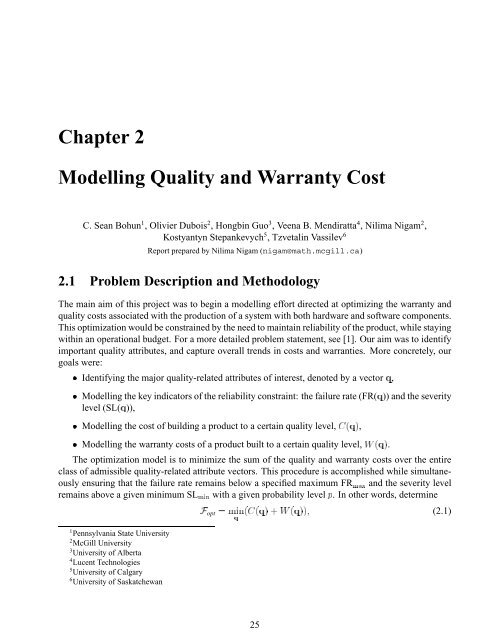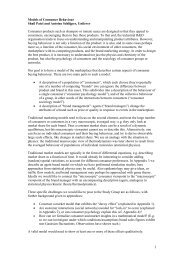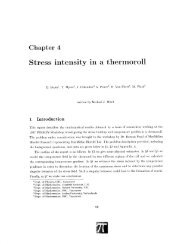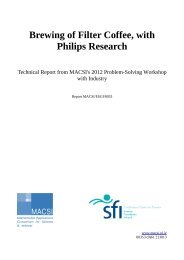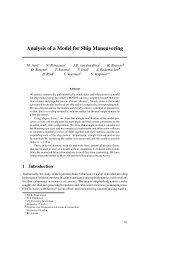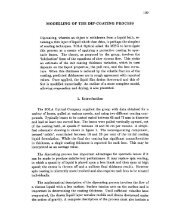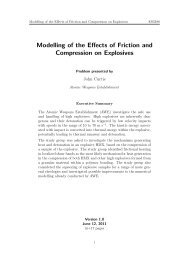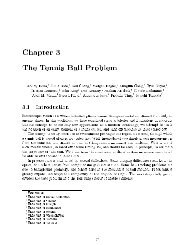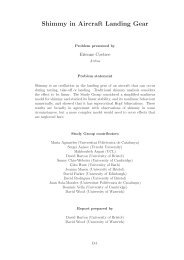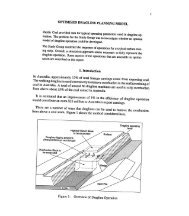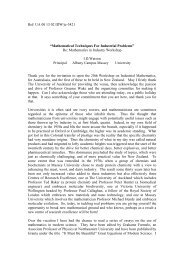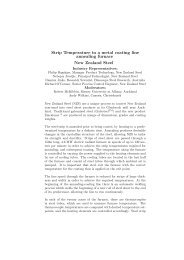Chapter 2 Modelling Quality and Warranty Cost - Mathematics in ...
Chapter 2 Modelling Quality and Warranty Cost - Mathematics in ...
Chapter 2 Modelling Quality and Warranty Cost - Mathematics in ...
Create successful ePaper yourself
Turn your PDF publications into a flip-book with our unique Google optimized e-Paper software.
<strong>Chapter</strong> 2<br />
<strong>Modell<strong>in</strong>g</strong> <strong>Quality</strong> <strong>and</strong> <strong>Warranty</strong> <strong>Cost</strong><br />
C. Sean Bohun 1 , Olivier Dubois 2 , Hongb<strong>in</strong> Guo 3 , Veena B. Mendiratta 4 , Nilima Nigam 2 ,<br />
Kostyantyn Stepankevych 5 , Tzvetal<strong>in</strong> Vassilev 6<br />
Report prepared by Nilima Nigam (nigam@math.mcgill.ca)<br />
2.1 Problem Description <strong>and</strong> Methodology<br />
The ma<strong>in</strong> aim of this project was to beg<strong>in</strong> a modell<strong>in</strong>g effort directed at optimiz<strong>in</strong>g the warranty <strong>and</strong><br />
quality costs associated with the production of a system with both hardware <strong>and</strong> software components.<br />
This optimization would be constra<strong>in</strong>ed by the need to ma<strong>in</strong>ta<strong>in</strong> reliability of the product, while stay<strong>in</strong>g<br />
with<strong>in</strong> an operational budget. For a more detailed problem statement, see [1]. Our aim was to identify<br />
important quality attributes, <strong>and</strong> capture overall trends <strong>in</strong> costs <strong>and</strong> warranties. More concretely, our<br />
goals were:<br />
r<br />
Identify<strong>in</strong>g the major quality-related attributes of <strong>in</strong>terest, denoted by a vector 9 ,<br />
<strong>Modell<strong>in</strong>g</strong> the key <strong>in</strong>dicators of the reliability constra<strong>in</strong>t: the failure rate (FR(9 )) <strong>and</strong> the severity<br />
level (SL(9 )),<br />
r<br />
<strong>Modell<strong>in</strong>g</strong> the cost of build<strong>in</strong>g a product to a certa<strong>in</strong> quality level, ä ‚9; ,<br />
r<br />
<strong>Modell<strong>in</strong>g</strong> the warranty costs of a product built to a certa<strong>in</strong> quality level, j‚9; .<br />
The optimization model is to m<strong>in</strong>imize the sum of the quality <strong>and</strong> warranty costs over the entire<br />
class of admissible quality-related attribute vectors. This procedure is accomplished while simultaneously<br />
ensur<strong>in</strong>g that the failure rate rema<strong>in</strong>s below a specified maximum FR687:9 <strong>and</strong> the severity level<br />
rema<strong>in</strong>s above a given m<strong>in</strong>imum SL68;=< with a given probability level > . In other words, determ<strong>in</strong>e<br />
1 Pennsylvania State University<br />
2 McGill University<br />
3 University of Alberta<br />
4 Lucent Technologies<br />
5 University of Calgary<br />
6 University of Saskatchewan<br />
opt ¥§¤ž ? ä ‚9;Lxj:95€ (2.1)<br />
7<br />
25
J<br />
26 CHAPTER 2. MODELLING QUALITY AND WARRANTY COST<br />
subject to<br />
ê+ FR‚9;A@ FR687:9÷B@C>¸ ê+ SL:9WÆ SL68;= (2.2)<br />
over all admissible 9 . In this project we did not perform this optimization, focus<strong>in</strong>g <strong>in</strong>stead on the<br />
modell<strong>in</strong>g of the function <strong>in</strong>volved.<br />
It is important to note at this juncture that no raw data from Lucent was provided for this project,<br />
nor did we have specific <strong>in</strong>formation about the particular products be<strong>in</strong>g built. It was therefore not<br />
feasible to use exist<strong>in</strong>g hazard/risk models for the various components. Our modell<strong>in</strong>g effort was thus<br />
critically dependent on discussions with the <strong>in</strong>dustrial contact, Prof. Veena Mendiratta. In the section<br />
on future directions we make a series of recommendations which will help ref<strong>in</strong>e the models <strong>in</strong>volved.<br />
We systematically identified the key quality-related attributes, described by a quality vector 9 ,<br />
which could be measured <strong>and</strong> quantified. We then developed reliability, warranty <strong>and</strong> cost models<br />
based on these. As our discussions progressed, it became clear that these quality attributes were not<br />
all <strong>in</strong>dependent. Nor were they all equally important <strong>in</strong>dicators of overall quality. It is thus possible to<br />
simplify the models considerably by focus<strong>in</strong>g on the effects of the most important attributes, mak<strong>in</strong>g<br />
the optimization problem (2.1) simpler to solve. In practice, once cost functions <strong>and</strong> parameters have<br />
been picked on the basis of st<strong>and</strong>ard hazard models, it will be possible via scal<strong>in</strong>g arguments to achieve<br />
further simplification.<br />
With a view to illustrat<strong>in</strong>g qualitative trends predicted by our models, we generated some test data<br />
(see Subsection 2.8), <strong>and</strong> ran our models on them. The graphs presented <strong>in</strong> this report are therefore<br />
not l<strong>in</strong>ked to any true data, <strong>and</strong> serve only to provide qualitative <strong>in</strong>formation.<br />
2.1.1 A Road Map<br />
The follow<strong>in</strong>g list details the strategy for this report. Figure 2.1 illustrates how the various sections of<br />
the report <strong>in</strong>terconnect.<br />
Section 2: In this section we identify the quality-related variables, D , which drive the various<br />
costs associated with a product, <strong>and</strong> over which the optimization will occur. The fact that many<br />
of these variables are not <strong>in</strong>dependent will be dealt with later <strong>in</strong> this report.<br />
Section 3: Here, we develop models for the reliability constra<strong>in</strong>ts, the failure rate FR <strong>and</strong> the<br />
severity levels SL. As well as provid<strong>in</strong>g some graphical <strong>in</strong>sight <strong>in</strong>to the dependence of these<br />
models on the quality D , we also discuss how these failure rates determ<strong>in</strong>e the probability of the<br />
various modes of failure. These probabilities play a role <strong>in</strong> determ<strong>in</strong><strong>in</strong>g the warranty costs of a<br />
product.<br />
Section 4: At this po<strong>in</strong>t <strong>in</strong> the report a model EGFDIH for , the cost of implementation of a given<br />
quality D level is proposed.<br />
Section 5: This conta<strong>in</strong>s the development of the warranty models for J hardware<br />
sw aspects of a product.<br />
hw <strong>and</strong> software<br />
Section 6: Here we comb<strong>in</strong>e the models to summarize the total proposed optimization problem.<br />
Section 7: A sensitivity to parameters is discussed, provid<strong>in</strong>g <strong>in</strong>sight <strong>in</strong>to the relative importance<br />
of terms <strong>in</strong> the various models that have been <strong>in</strong>troduced.
S<br />
УÑÓÒÕÔWÖ×ÙØnÚMÛÝÜÞ×àß<br />
á£âÓãÕäWå5æç¤åéèÝê<br />
ë£ìÓíÕîWï5ðñnò¡óÝôWõ<br />
2.2. QUALITY ATTRIBUTES VECTOR 27<br />
/.0<br />
XWLTYZV QR[<br />
KML¤N¤L¤OP¤QRLBPTS¤L¤UWV<br />
f gRhMij_kgRa¤\<br />
\]_^¤`¤a¤b&c¤d¤]¤e<br />
¢¤ ¢!#"%$'&)(+*<br />
¢¡¤£¦¥¨§©<br />
1.2<br />
3.4.576<br />
lnm¤op¤qZm¤or<br />
sut¤vRwRxZy¤z{<br />
=.?A@<br />
Ã5Ä¤Å Æ Ç¤ÈÉBÈĤÊRÉÌËÃÎÍÏ<br />
|n}8|¤~T|¤T|¤€<br />
¤‚T¤ƒT¤„B¤…T¤†<br />
u·¤¸W·¤¹º »R¼M½ ·¤¸W·¤½¿¾ ÁÀ¡Â<br />
,.-<br />
‡Mˆ¤‰¤Š ‹ ŒR<br />
ö£÷ÓøÕùWú5ûü¤úMýþ¿ÿ<br />
8.9.:7;<br />
B.C.DAE<br />
§n¨¤©ª¤«Z¨¤©¬T«Z¨¤©©¨_¤®R¯¡° ±³²:´+µ<br />
–$—¤˜RRšZ›¤œTšZ›¤œœ›¤ž¤RŸ¡ ¢©£¥¤+¦<br />
FG<br />
ŽW¤R‘¤’W“”¤•W<br />
Figure 2.1: Illustrated are the various sections of this report <strong>and</strong> how they <strong>in</strong>terconnect.<br />
Section 8: Broad trends <strong>in</strong> the proposed models are generated by draw<strong>in</strong>g the quality-related<br />
variables from a given probability distribution. Two cases are considered, each characterized by<br />
the probability distribution be<strong>in</strong>g used.<br />
2.2 <strong>Quality</strong> Attributes Vector<br />
We beg<strong>in</strong> by identify<strong>in</strong>g the important quality-related attributes which are both salient <strong>and</strong> measurable<br />
<strong>in</strong> the context of this project. These attributes fall <strong>in</strong>to two broad categories – hardware-related <strong>and</strong><br />
software-related – <strong>and</strong> the optimization of the total cost will be performed over these attributes. In<br />
practice, most of these attributes will be measured statistically. In the absence of raw data, we are<br />
unable to provide statistical models for these attributes, which will change depend<strong>in</strong>g on the product.<br />
Mathematically, these attributes are gathered <strong>in</strong> a quality vector<br />
K.LMJON#L JOP#LMQQQRLMJTSHVUXWZYRH\[^]L)_` Q<br />
DIH4F7J<br />
The cost will be optimized as a function DaUbW of , subject to certa<strong>in</strong> reliability constra<strong>in</strong>ts. We<br />
have scaled these J>c attributes to take on values between 0 <strong>and</strong> 1 for convenience. This enables us to<br />
compare, for example, a quantity orig<strong>in</strong>ally measured as a percentage with one measured as a number<br />
between 0 <strong>and</strong> 10. When us<strong>in</strong>g the model <strong>in</strong> application, it will be important to identify the units used<br />
<strong>and</strong> convert them if necessary.<br />
The various quality attributes are described below.<br />
HARDWARE:<br />
: Component quality. In practice measured as a failure rate percentage per year. Here, this rate is<br />
JMK<br />
converted to a scale from 0 to 1, <strong>and</strong> is JMK called .
r<br />
28 CHAPTER 2. MODELLING QUALITY AND WARRANTY COST<br />
: Infant mortality factor (IMF). Measured as the ratio of the <strong>in</strong>itial failure rate to the steady-state<br />
JON<br />
failure rate, this is a number between 1 <strong>and</strong> 2. In this project, we use the JONdH scal<strong>in</strong>g measured<br />
<strong>in</strong>fant mortality ef_ factor .<br />
: Diagnostics capability. This attribute is denoted JOP <strong>and</strong> lies between 0.8 <strong>and</strong> 1. In practice, it is<br />
JOP<br />
measured as a percentage, typically between 80 <strong>and</strong> 100.<br />
: Work<strong>in</strong>g environment range. The variable JTg is def<strong>in</strong>ed as the amount by which the constructed<br />
JOg<br />
work<strong>in</strong>g range exceeds the specifications of the device. For example, suppose the device is <strong>in</strong>tended<br />
to operate ]ih between C _])]ih <strong>and</strong> C, but is built with a work<strong>in</strong>g range ej_]ih of C _k)lih to C.<br />
The constructed work<strong>in</strong>g range exceeds the operational specifications _]ih by C on the lower end,<br />
<strong>and</strong> k)lih by C on the higher end. Thus, we would JOgmH compute<br />
From the description of these hardware-related attributes, it is not immediately obvious which are the<br />
best <strong>in</strong>dicators of overall quality.<br />
l)qs_])]tHu])Q<br />
l .<br />
FO_]onpk)lH>qF work<strong>in</strong>g rangeHoH<br />
SOFTWARE:<br />
: Software development environment (SDE). Denoted JTv , this describes the overall quality metric<br />
JOv<br />
of the software development process.<br />
: Code complexity. This metric measures the complexity of a code based on a variety of <strong>in</strong>dicators.<br />
JOw<br />
Essentially, the more complicated the <strong>in</strong>teractions between different parts of a large code, the<br />
harder it is to ensure reliability.<br />
: Stability <strong>in</strong>dex. Typically a number between 0.8 <strong>and</strong> 1, this metric describes the robustness of a<br />
JMx<br />
code over longer periods of time.<br />
: Coverage test<strong>in</strong>g. This attribute describes how comprehensively each module of the code has<br />
JOy<br />
been checked.<br />
: Fault density. This measures the number of failures per 1000 l<strong>in</strong>es of code. We express this as a<br />
JOS<br />
fraction between 0 <strong>and</strong> 1.<br />
The SDE <strong>in</strong>dex clearly seems to <strong>in</strong>clude, or be affected by, the other software-related attributes. We<br />
expect a good model will therefore be very sensitive to changes <strong>in</strong> JOv . In particular cases, these quality<br />
attributes may be restricted to tighter “operat<strong>in</strong>g ranges” by the company’s production policies.<br />
2.3 How do we Model the Reliability Constra<strong>in</strong>ts?<br />
The optimization of the costs of quality <strong>and</strong> warranty would be straightforward <strong>in</strong> the absence of<br />
certa<strong>in</strong> reliability constra<strong>in</strong>ts. These constra<strong>in</strong>ts are identified as benchmarks, or st<strong>and</strong>ards, which<br />
must be met by any product. The quality attributes must be chosen to meet or exceed these st<strong>and</strong>ards.<br />
Prior to prescrib<strong>in</strong>g the nature of the constra<strong>in</strong>ts, we need to model the <strong>in</strong>dicators of reliability<br />
which will be used. There are two major <strong>in</strong>dicators, one for hardware <strong>and</strong> one for software.
2.3. HOW DO WE MODEL THE RELIABILITY CONSTRAINTS? 29<br />
HARDWARE:<br />
Failure Rate (FR): this is described by the system failure rate per year, <strong>and</strong> <strong>in</strong>cludes the<br />
effect of the component failure rate J K .<br />
SOFTWARE:<br />
Severity Levels (SL): ranges <strong>in</strong> scale from 1 to 4, where SL Hz_ is a catastrophic failure,<br />
<strong>and</strong> SL H|{ is a m<strong>in</strong>or error.<br />
The reliability constra<strong>in</strong>ts will be <strong>in</strong>terpreted <strong>in</strong> terms of these <strong>in</strong>dicators – the failure rate FR must be<br />
below a certa<strong>in</strong> prescribed value with high probability, <strong>and</strong> the severity level SL must stay away from<br />
the catastrophic failures with high probability. This is illustrated <strong>in</strong> expression (2.2).<br />
2.3.1 <strong>Modell<strong>in</strong>g</strong> the Failure Rate<br />
The failure rate used <strong>in</strong> the characterization of reliability comb<strong>in</strong>es several factors <strong>in</strong>clud<strong>in</strong>g the failure<br />
rate of the components themselves, the robustness of the overall architecture, the <strong>in</strong>fant mortality factor<br />
(IMF) <strong>and</strong> the work<strong>in</strong>g environment range.<br />
We identified the broad trends that the failure rate exhibited <strong>in</strong> three of the quality attributes: component<br />
failure rate JMK , the <strong>in</strong>fant mortality factor JON <strong>and</strong> the work<strong>in</strong>g environment range JOg . As the<br />
component failure rate JMK <strong>in</strong>creases, so does the overall failure rate. Likewise, if the IMF JTN is high,<br />
the failure rate is large. The effect of the work<strong>in</strong>g range environment JOP is opposite: if the constructed<br />
work<strong>in</strong>g range is larger than the specs, the device is more robust <strong>and</strong> thus the failure rate goes down.<br />
We proposed two models with <strong>in</strong>creas<strong>in</strong>g complexity that exhibit this behaviour. Our discussions<br />
revealed that <strong>in</strong> this specific context the failure rate was described largely <strong>in</strong> terms of the component<br />
quality.<br />
The first model FRK_FDMH is a simple one, with 3 free parameters }~K , }N , <strong>and</strong> }P :<br />
FRKFDIHH FRK¤F7JMK.L JON#LMJTgHH€})KsJ K n‚}NƒJON„e…}PuFO_e…JMKH>JOgQ (2.3)<br />
The nonl<strong>in</strong>ear term e†}PuF>_‡e€JMKH>JOg enters s<strong>in</strong>ce the failure rate should decrease with larger work<strong>in</strong>g<br />
environment range JTg , however the system will nevertheless be affected by poor component failure<br />
rates J K . These two effects are therefore compet<strong>in</strong>g.<br />
Figure 2.2 below shows four graphs related to failure rate model FRK . The first three graphs exhibit<br />
the trends of the failure rate with respect to the <strong>in</strong>dividual attributes JMK , JTN , JOg . The last graph depicts a<br />
surface plot describ<strong>in</strong>g failure rate trends when J K <strong>and</strong> JOg are allowed to change.<br />
The next failure rate model we propose is manifestly nonl<strong>in</strong>ear, <strong>and</strong> aims to better capture the<br />
importance of the component failure rate J K on the system failure rate FR. The free parameters are<br />
denoted }~K , }N , }P <strong>and</strong> }g . As before, the failure rate FR depends on the quality vector D , but <strong>in</strong><br />
particular on the attributes JMK , JTN , JOg .<br />
N<br />
e…}guFO_e…JMKH>JOgQ (2.4)<br />
K<br />
K>LMJTNLMJOg_HVH|})Ksˆ¦‰¦ŠŒ‹.Žn…}P JONMJ<br />
FRNuF7J<br />
The rationale for pick<strong>in</strong>g this model is as follows: first, the system failure FRF DMH rate <strong>in</strong>creases with<br />
poorer component quality, with this rate of change depend<strong>in</strong>g JMK on . Therefore the dependence of
30 CHAPTER 2. MODELLING QUALITY AND WARRANTY COST<br />
0.24<br />
FR1 v/s q1, q2=0.3<br />
0.5<br />
FR1 v/s q2, q4=0.3<br />
0.22<br />
0.2<br />
0.4<br />
0.18<br />
0.16<br />
0.3<br />
0.14<br />
0.12<br />
0.2<br />
0.1<br />
0.08<br />
0.06<br />
q4=0.1<br />
q4=0.5<br />
q4=0.8<br />
0.1<br />
q1=0.1<br />
q1=0.5<br />
q1=0.8<br />
0.04<br />
0 0.1 0.2 0.3 0.4 0.5 0.6 0.7 0.8 0.9 1<br />
Component Failure Rate q1<br />
0.25<br />
(a)<br />
FR1 v/s q4, q4=0.3<br />
0<br />
0 0.1 0.2 0.3 0.4 0.5 0.6 0.7 0.8 0.9 1<br />
Infant Mortality Factor q2<br />
(b)<br />
q1=0.1<br />
q1=0.5<br />
q1=0.8<br />
1<br />
0.9<br />
0.22<br />
0.2<br />
0.8<br />
0.2<br />
0.15<br />
0.1<br />
Work<strong>in</strong>g Environment Range<br />
0.7<br />
0.6<br />
0.5<br />
0.4<br />
0.3<br />
0.2<br />
0.18<br />
0.16<br />
0.14<br />
0.12<br />
0.1<br />
0.08<br />
0.05<br />
0 0.1 0.2 0.3 0.4 0.5 0.6 0.7 0.8 0.9 1<br />
Work<strong>in</strong>g Environment Range q4<br />
(c)<br />
0.1<br />
0<br />
0 0.1 0.2 0.3 0.4 0.5 0.6 0.7 0.8 0.9 1<br />
Component Failure Rate<br />
(d)<br />
0.06<br />
Figure 2.2: Failure Rate FRK model as a function of (a) component J K quality , (b) <strong>in</strong>fant JON mortality ,<br />
(c) work<strong>in</strong>g environment JOg range , <strong>and</strong> (d) JMK both JTg <strong>and</strong> JTNdH|]Q<br />
together, .
2.3. HOW DO WE MODEL THE RELIABILITY CONSTRAINTS? 31<br />
0.25<br />
FR2 v/s q1, q2=0.3<br />
0.25<br />
FR2 v/s q2, q4=0.3<br />
q1=0.1<br />
q1=0.5<br />
q1=0.8<br />
0.2<br />
0.2<br />
0.15<br />
0.15<br />
0.1<br />
q4=0.1<br />
q4=0.5<br />
q4=0.8<br />
0.05<br />
0 0.1 0.2 0.3 0.4 0.5 0.6 0.7 0.8 0.9 1<br />
Component Failure Rate q1<br />
(a)<br />
0.1<br />
0 0.1 0.2 0.3 0.4 0.5 0.6 0.7 0.8 0.9 1<br />
Infant Mortality Factor q2<br />
(b)<br />
Figure 2.3: Failure Rate model FRN as a function of (a) component quality JMK , <strong>and</strong> (b) <strong>in</strong>fant mortality<br />
JON .<br />
on JMK is modelled by an exponential. Second, the <strong>in</strong>itial mortality rate JOg impacts the overall failure<br />
FRN<br />
rate, but even if this IMF is low, a poor-quality component will impact the failure rate adversely.<br />
The two graphs <strong>in</strong> Figure 2.3 use the failure model (2.4) for FR to describe the broad trends <strong>in</strong> the<br />
model with component failure J K rate <strong>and</strong> <strong>in</strong>fant mortality JON factor <strong>and</strong> can be compared to Figure 2.2.<br />
In Section 2.8 we show the effect of <strong>in</strong>putt<strong>in</strong>g several <strong>in</strong>stances D of , drawn from test data, <strong>in</strong>to the<br />
FRN model .<br />
2.3.2 <strong>Modell<strong>in</strong>g</strong> the Severity Level<br />
Software failures are characterized <strong>in</strong> terms of vary<strong>in</strong>g severity levels (hereafter denoted SL), where<br />
an H _ SL is a catastrophic failure, while an Hu{ SL is a m<strong>in</strong>or failure. In this section we present some<br />
models describ<strong>in</strong>g the relationship between the quality D vector <strong>and</strong> the SL.<br />
In the context of this specific project, we determ<strong>in</strong>ed that the severity levels of software failure were<br />
impacted by the software development environment JOv , the code complexity JOw , the stability <strong>in</strong>dex JMx ,<br />
the coverage test<strong>in</strong>g JOy <strong>and</strong> the fault density JTS . The model we propose for the severity levels is not<br />
an additive/l<strong>in</strong>ear one. We believe that the chosen functional form captures well the trends <strong>in</strong> severity<br />
levels as functions of the <strong>in</strong>dividual attributes, as well as the relative importance amongst these factors.<br />
There are some free (nonnegative) parameters <strong>in</strong> the model, ‘’K , ‘N , ‘¦P , ‘¦g , ‘¦v . The severity level SL as<br />
a function of D is:<br />
N<br />
Q (2.5) x<br />
SLK_FDIHH<br />
SLK¤F7JOvL JOw#LMJ x.LMJOyMLMJOS_HVH|‘¢K.ˆ¦“ Š•”‹T–˜—~š<br />
y<br />
“>› ”‹Tœ•—~š<br />
K<br />
” JTv„n F>_žn…JTwŸe J<br />
”A—<br />
N<br />
H¡“T¢¦J w<br />
To describe the effects of coverage test<strong>in</strong>g JOy , we noted that as JTy <strong>in</strong>creases, the likelihood of<br />
catastrophic software error decreases s<strong>in</strong>ce more of the software is validated. Similarly, as the number<br />
of faults per 1K l<strong>in</strong>es, JTS , <strong>in</strong>creases, so does the risk of catastrophic error. Keep<strong>in</strong>g <strong>in</strong> m<strong>in</strong>d the scale
N<br />
32 CHAPTER 2. MODELLING QUALITY AND WARRANTY COST<br />
4.5<br />
Severity Level<br />
1<br />
Severity Levels<br />
4.5<br />
4<br />
3.5<br />
0.9<br />
0.8<br />
4<br />
3<br />
0.7<br />
3.5<br />
2.5<br />
2<br />
1.5<br />
Code Complexity<br />
0.6<br />
0.5<br />
0.4<br />
0.3<br />
3<br />
2.5<br />
2<br />
1<br />
0.2<br />
1.5<br />
0.5<br />
0.1<br />
0<br />
0 0.1 0.2 0.3 0.4 0.5 0.6 0.7 0.8 0.9 1<br />
SDE<br />
(a)<br />
0<br />
0 0.1 0.2 0.3 0.4 0.5 0.6 0.7 0.8 0.9 1<br />
SDE<br />
(b)<br />
1<br />
Figure 2.4: Severity levels as a function of the various components of the quality-related vector: (a)<br />
SDE JTv , (b) SDE <strong>and</strong> code complexity F£JOvLMJTw_H .<br />
on which we measure SL, the dependence on JTy <strong>and</strong> JOS is modelled by exponentials with appropriate<br />
signs, penaliz<strong>in</strong>g deviations from high-quality.<br />
Based on discussions, we modelled the dependence of SL on the stability <strong>in</strong>dex J x by a quadratic,<br />
s<strong>in</strong>ce a more stable code is less prone to severe software failures.<br />
As the software development environment <strong>in</strong>dicator JOv <strong>in</strong>creases, the types of software failures get<br />
less severe <strong>and</strong> the SL <strong>in</strong>creases. Poor quality development environment impacts the severity level<br />
more. That is, ¤¦F SLH>q)¤¥JOv should be larger for small values JOv . This behaviour is captured well by the<br />
square root function.<br />
The opposite trend is exhibited as a function of code complexity JTw . When the code complexity is<br />
low, the overall software is less prone to severe errors, putt<strong>in</strong>g the SL <strong>in</strong>dex <strong>in</strong> the high range. After a<br />
certa<strong>in</strong> threshold complexity is exceeded, the effect of complexity on the severity levels becomes less<br />
dramatic. To capture this behaviour, the dependence of SL JOw on is described F>_n¦JOw§e¦J w H “ ¢ by where<br />
@\_ . ‘¦g<br />
While discuss<strong>in</strong>g SL it appeared that the JOy attributes JTS , , the coverage test<strong>in</strong>g <strong>and</strong> fault density,<br />
were well-predicted by the software development JOv environment, . Therefore, we assumed that at least<br />
for the purpose of modell<strong>in</strong>g severity levels as a function D of , we could write<br />
This suggests a possible simplification to the severity level model:<br />
H€©«ª y JOvL JOÿ<br />
S JTvQ (2.6)<br />
JTSdHu©«ª<br />
N<br />
Q (2.7)<br />
x<br />
SLNuFDMHVH<br />
” JTv„n F>_§n…JTwŸe J<br />
SLNuF£JOv#L JOwLMJ xHVHu‘’K.ˆ — “>¬ ”‹ ¬ —~š<br />
y<br />
N<br />
H¡“ ¢ J w<br />
‘¢K where ‘¦g <strong>and</strong> are as <strong>in</strong> model (2.5), ‘¦vHZ‘¦N© ª S e®‘PM© ª<br />
while<br />
graphically described <strong>in</strong> the Figure 2.4.<br />
y . The trends <strong>in</strong> the severity level are
F<br />
r<br />
r<br />
Probability of an SL type º failure H<br />
c<br />
c<br />
n<br />
c<br />
K<br />
N<br />
N<br />
SLF£JOv#LMJTwLMJMx¡HH¾º¦¿<br />
³j»F£JOvLMJTw#LMJMxHVUX¼X½<br />
JOwLMJ xHUÀ¼¿<br />
³j»F£JOw#L<br />
ÈTSJTS<br />
ªS JOwn…È<br />
N<br />
n<br />
L<br />
2.4. THE COST OF QUALITY IMPLEMENTATION 33<br />
Failure<br />
F£‘¢KOLM‘¦g#LM‘¦v_H<br />
U F£]L)_ QlÎH<br />
SL U Q¯lL 0.9 % 0.1 % 0.8 F>_ %<br />
k)QlH<br />
type (2.46,0.4,1) (2.46,0.6,1) (2.46,0.4,2) (2.46,0.4,3)<br />
SL 0.1 % 0.01 % 0.01 % 0.02 %<br />
% 0.1<br />
U SL<br />
U SL<br />
QlH 12.7 % 14 % 29 % 43.5 %<br />
87.2 % 85.8 % 70.4 % 55.6 %<br />
Table 2.1: Predicted distribution of severity levels for various sets of F7‘’K.LM‘¦g#LM‘¦v_H .<br />
Even with this simplification, the severity model described by equation (2.7) is highly nonl<strong>in</strong>ear.<br />
How is one to choose the exponent ‘¦g ? Does this model actually capture the observed behaviour of<br />
software systems when they are built with<strong>in</strong> a given range of quality?<br />
To answer these questions, we first determ<strong>in</strong>ed the heuristic trend: if the software development<br />
JOv JOw JMx<br />
H _ H±k ])Q¡_°<br />
H<br />
_])° Hu{ _° ²)l)°<br />
F7JTv#LMJOwL JMxH<br />
F£JOv#LMJTwLMJMx¡H ³voH´]Q¯² ³wtH€]Q¯{<br />
³xµH ]Q² H ]Q¯])l so ¹ that JTv¸· F£])Q²L]Q]~lH , JTw¸· <strong>and</strong><br />
¹ F£])Q{L]Q]~lH<br />
]Q¯])lH F']Q²)L<br />
environment , the code complexity <strong>and</strong> the stability <strong>in</strong>dex were <strong>in</strong> the high-end, then the number<br />
of software failures classified as SL (catastrophic) should be less than , SL failures<br />
should be about , SL failures should be less than <strong>and</strong> SL failures should be about .<br />
A good reality check for our SL model (2.7) is to draw from a given set of distributions.<br />
For our first simulation we take from normal distributions with means , ,<br />
<strong>and</strong> a common variance<br />
. The probability of each SL failure type can be computed through<br />
JMxV·´¹<br />
¼‚YH€»”F7J v LMJ w LMJ x H ˜˜ cÂÁsK ½ÃJOvd·€¹ F']Q¯²L ]Q¯])lH>LMJOẅ ·€¹ F']Q¯{L ]Q¯])lH>LMJMx·´¹ F']Q²)L ]Q¯])lH.¿ where is a set of 1000<br />
i.i.d. test data po<strong>in</strong>ts drawn from the appropriate normal distributions, ³ÌF£ÄBH <strong>and</strong> is the volume of a set<br />
. We show <strong>in</strong> Table 2.1 these (approximate) percentages for a few choices of ‘’K>LM‘¦v <strong>and</strong>, critically,<br />
Ä<br />
. We note that these ranges are not obta<strong>in</strong>ed from Lucent, but are used because they seem consistent<br />
‘¦v<br />
with a high-end product. The JOw code-complexity was set to be mid-range s<strong>in</strong>ce a marketable system<br />
would have a certa<strong>in</strong> m<strong>in</strong>imal level of complexity, but high complexity was undesirable.<br />
2.4 The <strong>Cost</strong> of <strong>Quality</strong> Implementation<br />
Hav<strong>in</strong>g identified the constra<strong>in</strong>ts <strong>in</strong> the previous section, we now describe the costs associated with<br />
build<strong>in</strong>g a product with given quality D vector . Our discussion revealed that the largest effects on<br />
the cost were due to ma<strong>in</strong>ta<strong>in</strong><strong>in</strong>g a high software development JTv environment , <strong>and</strong> a low component<br />
failure J K rate .<br />
The model for the cost of E F DMH quality, which is proposed <strong>in</strong> this project is<br />
E F DMHÅH E hw n)E sw<br />
H EK>ˆ —)Æ¥Ç ‹¦ n‚ÈTNuF£JONn…È ªN H<br />
n…ÈÉP#JTP„n‚ÈTg F£JOgn…È ªg H<br />
fixed hardware costs<br />
n fixed software costsQ<br />
(2.8)<br />
Æ Ç ¬ ‹ ¬ n…ÈÉw#JTw„n‚È x.J xn<br />
EžvMˆ
34 CHAPTER 2. MODELLING QUALITY AND WARRANTY COST<br />
200<br />
160<br />
154<br />
1<br />
0.9<br />
160<br />
140<br />
150<br />
155<br />
152<br />
150<br />
0.8<br />
0.7<br />
120<br />
100<br />
0 0.5 1<br />
q1<br />
158<br />
150<br />
0 0.5 1<br />
q2<br />
180<br />
148<br />
0 0.5 1<br />
q3<br />
156<br />
SDE<br />
0.6<br />
0.5<br />
100<br />
80<br />
156<br />
154<br />
152<br />
160<br />
140<br />
154<br />
152<br />
0.4<br />
0.3<br />
60<br />
150<br />
0 0.5 1<br />
q4<br />
154<br />
120<br />
0 0.5 1<br />
q5<br />
154<br />
150<br />
0 0.5 1<br />
q6<br />
154<br />
0.2<br />
40<br />
152<br />
153<br />
153.5<br />
0.1<br />
20<br />
150<br />
152<br />
153<br />
0<br />
0 0.1 0.2 0.3 0.4 0.5 0.6 0.7 0.8 0.9 1<br />
Component Failure Rate<br />
(a)<br />
148<br />
0 0.5 1<br />
q7<br />
151<br />
0 0.5 1<br />
q8<br />
(b)<br />
152.5<br />
0 0.5 1<br />
q9<br />
Figure 2.5: Behaviour of the quality function. (a) Trend <strong>in</strong> cost of quality as a function of component<br />
failure rate J K <strong>and</strong> SDE JTv . (b) Trend of cost of quality <strong>in</strong> <strong>in</strong>dividual attributes J>c .<br />
EK Here E ªK , Ežv , E ª v , ÈTN , È ªN , ÈÉP , ÈTg , È ªg , ÈTw , Èx , ÈÉS , È ªS , are constant parameters which need to be determ<strong>in</strong>ed<br />
by fitt<strong>in</strong>g actual data to the model.<br />
The first term of the hardware <strong>and</strong> software portions <strong>in</strong> this model capture the importance of the<br />
component failure J K rate <strong>and</strong> the software development JOv environment <strong>in</strong> the overall cost model. As<br />
decreases, the overall likelihood of failure decreases. This improvement costs more, especially after<br />
JMK<br />
a certa<strong>in</strong> threshold is achieved. Improvements beyond this level are <strong>in</strong>creas<strong>in</strong>gly expensive, as captured<br />
by an exponential function with the negative exponent. On the other h<strong>and</strong>, as JTv SDE <strong>in</strong>creases, the<br />
software development environment becomes better <strong>and</strong> thus costs more. These trends are captured <strong>in</strong><br />
Figures 2.5(a) <strong>and</strong> (b).<br />
The terms collected <strong>in</strong> equation (2.8) under hardware describe the effects of the <strong>in</strong>fant mortality<br />
JON rate , the diagnostics JTP capability <strong>and</strong> the work<strong>in</strong>g environment JOg range . In terms of the overall<br />
hardware quality costs, these are higher-order effects <strong>in</strong> the sense that their contribution may not be<br />
as significant as that of the component failure JMK rate, . This reason<strong>in</strong>g dictated the functional relationships<br />
as be<strong>in</strong>g at best quadratic. Similarly, the costs collected under software describe the effects of<br />
controll<strong>in</strong>g the code JTw complexity <strong>and</strong> the stability JMx <strong>in</strong>dex . These costs contribute less significantly<br />
to the overall quality costs for the software than the software development JTv environment . Indeed,<br />
the effects of <strong>in</strong>creas<strong>in</strong>g the coverage test<strong>in</strong>g <strong>and</strong> decreas<strong>in</strong>g the fault density are captured (to a large<br />
extent) by the cost JTv of , <strong>and</strong> are therefore ignored <strong>in</strong> this cost model. The trends of the cost as each of<br />
these attributes vary is pictured graphically <strong>in</strong> Figure 2.5. The results us<strong>in</strong>g the test data are described<br />
<strong>in</strong> Section 2.8.<br />
2.5 The <strong>Warranty</strong> <strong>Cost</strong>s<br />
<strong>Warranty</strong> costs can be broadly broken up <strong>in</strong>to the hardware <strong>and</strong> software costs, <strong>and</strong> we thus modelled<br />
each of these separately. As <strong>in</strong> the cost of quality, the dom<strong>in</strong>ant factors <strong>in</strong>volved are the component
J<br />
<br />
<br />
2.5. THE WARRANTY COSTS 35<br />
failure JMK rates <strong>and</strong> the software development JOv environment . We now present a model for the warranty<br />
J FDIH costs expressed as<br />
FDMHVH J hwFDMHn)J sw F DMH.Q<br />
J<br />
In this project we do not attempt to present a model for f<strong>in</strong>d<strong>in</strong>g an optimal warranty policy. Our<br />
attempt is to model the effect of chang<strong>in</strong>g quality on warranty costs for a given, fixed warranty policy.<br />
This dist<strong>in</strong>ction is an important one. Clearly, the policies themselves will change considerably if the<br />
average product quality attributes change a lot. This model does not account for this, at least <strong>in</strong> the<br />
hardware costs. However, as a first approximation, if we assume D the vector stays with<strong>in</strong> a certa<strong>in</strong><br />
range, the warranty policy may be considered fixed, <strong>and</strong> we can describe the effects on the warranty<br />
costs of D chang<strong>in</strong>g with<strong>in</strong> this range.<br />
2.5.1 The Hardware <strong>Warranty</strong> <strong>Cost</strong>s<br />
Hardware warranty costs are characterized by the four major types of hardware failures seen: no<br />
trouble found (NTF), repaired, junked, <strong>and</strong> further failure modes analysis (FMA). Of these, the NTF<br />
costs are the smallest, but the supplier may wish to penalize these. The model should be flexible enough<br />
so that an optimization will ensure that most of the errors fall <strong>in</strong>to the second (repaired) category.<br />
Empirical data will be able to describe the observed probabilities ÊŽK , ÊN , Ê)P <strong>and</strong> Ê)g of see<strong>in</strong>g the<br />
various warranty-related costs (NTF, repair, junk, <strong>and</strong> FMA, respectively). These probabilities are<br />
computed based on the assumption that the quality D vector lies with<strong>in</strong> a particular range, but are not<br />
sensitive to variations with<strong>in</strong> the range. There is also a st<strong>and</strong>ardized ˆK dollar ËN amount ËP , Ëg , ,<br />
associated with each of these.<br />
g<br />
The st<strong>and</strong>ard warranty cost model simply computes the Ì FàE³HÍH cÂÁsK Êic˨c expected cost . As a<br />
result this st<strong>and</strong>ard model fails to capture the most important trend, that of chang<strong>in</strong>g component failure<br />
rate J K , on the hardware warranty costs.<br />
To <strong>in</strong>clude the effects of quality, we penalize these four k<strong>in</strong>ds of failures to various degrees. This<br />
will allow the user, for example, to explicitly adjust the model so that NTF failures are reduced.<br />
This allows for greater flexibility <strong>in</strong> optimization. For example, NTF failures are <strong>in</strong>expensive, <strong>and</strong><br />
thus optimiz<strong>in</strong>g a st<strong>and</strong>ard warranty cost model may result <strong>in</strong> D choos<strong>in</strong>g values which <strong>in</strong>crease NTF<br />
failures, while reduc<strong>in</strong>g the expensive FMA failures. By contrast, the proposed hardware warranty<br />
model (2.9) allows the user to choose the penalty parameters ÎÏK , Î#N , Î#P , Î#g so that the optimal D values<br />
result <strong>in</strong> a small number of NTF.<br />
hwF DMHH‚Ë<br />
ÊŽKM[ˆKÐn…ÎÑKF>_e…JTPH>`<br />
NTF costs<br />
where Ê¥KVHu])Q¡_ , ÊNdH|]Q² , <strong>and</strong> ÊP¨H‚Êg¨H|]Q¯])l .<br />
FÒËN„n‚Î#N#JON_H<br />
nIÊN<br />
repair costs<br />
FÒËPn‚Î#P#JMKH<br />
nÓÊP<br />
junk costs<br />
F>_e…JTPH>`<br />
nÓÊg[Ëg„n‚Î#g<br />
FMA<br />
These probabilities are based on how many items which are returned to the supplier (<strong>and</strong> are ad<br />
hoc), Ë while is used to scale costs appropriately by the number of items <strong>in</strong> service. We notice that the<br />
st<strong>and</strong>ard warranty cost model has been multiplied JMK by , the component failure rate. In the proposed<br />
model if the component failure JMK rates are at the high end of the operat<strong>in</strong>g range, then the warranty<br />
costs are higher. Figure 2.6 depicts the various dependencies.<br />
(2.9)<br />
J K
xHUÀ¼¦½ SLF7JOvL JOw#LMJ xHH‚º¦¿<br />
³j»F£JOvLMJTw#LMJ<br />
JMxHVUÀ¼¿<br />
³j»F7JTwLMJOw#L<br />
Û<br />
H|ÜÞÝß à FÝE F DMHn/J FDIHH.L<br />
opt<br />
36 CHAPTER 2. MODELLING QUALITY AND WARRANTY COST<br />
25<br />
Hardware <strong>Warranty</strong> <strong>Cost</strong>s v/s q2, q3=0.8<br />
10<br />
Hardware Wararnty <strong>Cost</strong>s v/s q2, q1=0.3<br />
30<br />
Hardware <strong>Warranty</strong> <strong>Cost</strong>s v/s q1, q2=0.3<br />
20<br />
9.5<br />
25<br />
9<br />
20<br />
15<br />
8.5<br />
15<br />
10<br />
8<br />
5<br />
q1=0.1<br />
q1=0.5<br />
q1=0.8<br />
7.5<br />
7<br />
q3=0.1<br />
q3=0.5<br />
q3=0.8<br />
10<br />
5<br />
q3=0.1<br />
q3=0.5<br />
q3=0.8<br />
0<br />
0 0.1 0.2 0.3 0.4 0.5 0.6 0.7 0.8 0.9 1<br />
Infant Mortality Factor q2<br />
6.5<br />
0 0.1 0.2 0.3 0.4 0.5 0.6 0.7 0.8 0.9 1<br />
Infant Mortality Factor q2<br />
0<br />
0 0.1 0.2 0.3 0.4 0.5 0.6 0.7 0.8 0.9 1<br />
Component Failure Rate q1<br />
(a) (b) (c)<br />
Figure 2.6: (a) Trends J <strong>in</strong> hw with component JMK quality <strong>and</strong> JON IMF (JOP , fixed). (b) Trends J <strong>in</strong> hw<br />
with JTN IMF <strong>and</strong> diagnostics JOP capability (JMK , fixed). (c) Trends J <strong>in</strong> hw with component JMK quality <strong>and</strong><br />
diagnostics JOP capability (JON , fixed).<br />
2.5.2 The Software <strong>Warranty</strong> <strong>Cost</strong>s<br />
The software warranty costs are characterized <strong>in</strong> terms of the severity levels of the software failures,<br />
SL (see Section 2.3.2). Therefore, given the operat<strong>in</strong>g range of the quality vector D , we can calculate<br />
from our SL model the probabilities Êv , Ê)w , ÊŽx , Êy of failures of SL HZ_ (catastrophic) through SL H®{<br />
(m<strong>in</strong>or) respectively (see Table 2.1). Associated with each of these types of failures is a warranty cost,<br />
Ëv , Ëw , ˆx <strong>and</strong> Ëy respectively. The warranty cost for software is expressed by:<br />
J sw FDMHVH J FO_e…JOvH_F¯Êv>ËvVnÔÊw.ËwVnÕÊŽx7ˆxÐnÕÊ)y>Ëy_H.Q (2.10)<br />
The SDE most significantly impacts the warranty cost of the software. A higher SDE means fewer<br />
catastrophic failures. The probabilities Êic , º„H|lLMQMQMQL ² are fixed for a given operational range of JOv , JOw ,<br />
, <strong>and</strong> are chosen accord<strong>in</strong>g to our model of the Severity Level function (2.7). Recall that JTy <strong>and</strong> JOS<br />
JMx<br />
are given by expression (2.6). More precisely,<br />
n…סc<br />
ÊicŒÖ~gdH<br />
¼ÅYRH F£]Q¯²L_5HÙØ F']Q{)L ]Q¯ÚHÍØ F']Q¯ÚL_+H where . The וc quantities are <strong>in</strong>troduced to account for other<br />
lower-order effects, which are not accounted for dur<strong>in</strong>g the production. These <strong>in</strong>clude effects such as<br />
a product be<strong>in</strong>g returned due to <strong>in</strong>correct usage by the customer. One may also use a model allow<strong>in</strong>g<br />
more flexibility, such as (2.9). Unfortunately, <strong>in</strong> such a model the probabilities will need to be<br />
computed as functions JOc of .<br />
2.6 The Complete Model<br />
We now summarize the models of the previous sections. Recall that the goal was to identify the various<br />
functions <strong>in</strong> the optimization problem (2.1) repeated here for convenience
Û<br />
7 The general expression ú¡û ü is<br />
û<br />
H<br />
<br />
á<br />
Û<br />
N<br />
ð<br />
ð<br />
ë<br />
ë<br />
H<br />
<br />
í<br />
ð<br />
g<br />
ü<br />
á<br />
í<br />
N<br />
¤dö÷)ø„ë<br />
î ¤¥}<br />
N<br />
¤Žë<br />
¤Ž}î<br />
ð<br />
}î<br />
 ½^}<br />
N<br />
ð<br />
í<br />
y<br />
2.7. MODEL JUSTIFICATION: SENSITIVITY TO PARAMETERS 37<br />
subject to<br />
over all D admissible <strong>and</strong> some preset Ê probability . The objective function consists of the comb<strong>in</strong>ed<br />
costs of quality (2.8) <strong>and</strong> warranty (2.9), (2.10):<br />
F FRF DMHA@<br />
FRâÐã˜ä HB@¾Ê¥L<br />
F SLFDIHVå<br />
SLâÐæAçÎHB@¸Ê<br />
H EGFDMHn)J F DMHVH EGFDMHn)J hwFDIHn/J swFDMH<br />
(2.11)<br />
EK>ˆ —)è£Ç ‹¦ n)Ežvˆ è£Ç¬ ‹ ¬ nÔË<br />
JMK<br />
ÊicR˨c+n<br />
J4F>_e JOv¤H<br />
ÊicR˨c<br />
cÂÁsK<br />
cÂÁ~v<br />
JTw„n‚È ªS<br />
fixed costs<br />
n…ÈÉN F£JONn…È ªN H<br />
n…ÈÉPJOPVn…ÈÉguF7JTg„n‚È ªg H<br />
n…ÈÉwJOwn…Èx>JMxn…ÈÉS<br />
JOS<br />
where the terms have been reordered. The reliability constra<strong>in</strong>ts are given by (2.4) <strong>and</strong> (2.7):<br />
nÕË<br />
JMK [ ÊŽKOÎÏK¤F>_e JOP_HnÔÊNÎ#N#JONnÕÊ)P#Î#P#JMKnÕÊgÎ#g FO_e…JOPHO`)n<br />
FRNuF£JMK>LMJTNLMJOg¤HéH<br />
})Ksˆ ‰¦ŠŒ‹. n…}PƒJTNJ<br />
K e }gnF>_e JMKH>JOg @<br />
FRâÐã˜ä<br />
SLNuF£JOv#LMJTwLMJMx¡HéH ‘¢K JOvˆ¦“ ¬ ‹ ¬ F>_že JTwH•“T¢.J<br />
x å<br />
SLâÐæAç<br />
where FRâÐã˜ä <strong>and</strong> SLâêæAç are specified by the user. One may also use other models proposed <strong>in</strong> Section<br />
2.3. This objective function is quite complicated. However, by reta<strong>in</strong><strong>in</strong>g only terms to lead<strong>in</strong>g<br />
order, we propose a simpler model Û which captures most of the behaviour:<br />
—)è Ç ‹. n…ÈÉvˆ è Ǭ ‹ ¬Ðn JÀK.J K n JÓN FO_e JOvH.Q<br />
FDMHVHuÈK.ˆ<br />
This simplification is justified numerically <strong>in</strong> Section 2.8.2.<br />
2.7 Model Justification: Sensitivity to Parameters<br />
cont<strong>in</strong>uously vary<strong>in</strong>g parameters on some<br />
Consider a ë FD ì#}~K>LM}N#LMQMQMQLM} í H function depend<strong>in</strong>g ¹ on<br />
¼ doma<strong>in</strong> . We assume ë that is sufficiently regular to ensure ¤¥ëq)¤¥} î that exists ¼ throughout . By<br />
consider<strong>in</strong>g the sequence of »} î¿<br />
í<br />
î.ÁsK parameters as a ï }ÔU vector the total differential ë of can be<br />
written as<br />
}õH ï<br />
} îQ<br />
ëñH€òpó<br />
䬙<br />
As a consequence, assum<strong>in</strong>g ë is positive valued 7 , one has<br />
î.ÁsK<br />
(2.12)<br />
½Ã}<br />
illustrat<strong>in</strong>g that the proportion of the relative change <strong>in</strong> the ë due to the relative change <strong>in</strong> the parameter<br />
} î is } î¤ùö÷)ø„ëq)¤¥} î . This simple formalism is used <strong>in</strong> the analysis that follows.<br />
î.ÁsK<br />
ü<br />
û<br />
üú ü .<br />
<br />
üÏý þÿ¡ £¢¥¤§¦ ÿ ¤ sgn¨©
ð<br />
ð<br />
FRN<br />
FRNѽ ½<br />
ð<br />
F<br />
ð<br />
H<br />
ð<br />
ð<br />
F<br />
SLN<br />
SLN<br />
H<br />
ð<br />
ð<br />
ð<br />
‘’K<br />
‘’K<br />
ð<br />
ð<br />
ð<br />
ð<br />
K<br />
‘¦v<br />
‘¦v<br />
ð<br />
F<br />
ð<br />
N<br />
ð<br />
ð<br />
‘g<br />
‘¦g<br />
ÈTSMJOS<br />
ªS H N F7JOwVn‚È ªS H<br />
F£JOwn…È<br />
ð<br />
ð<br />
ÈÉS<br />
ÈTS<br />
ð<br />
ð<br />
e<br />
ð<br />
Q<br />
ð<br />
38 CHAPTER 2. MODELLING QUALITY AND WARRANTY COST<br />
2.7.1 Failure Rate Model<br />
Recall that the second model for overall failure rate that we proposed <strong>in</strong> Section 2.3 was<br />
N<br />
e…}guFO_Ve‚JMKH.JTg<br />
K<br />
FDì#})K.LM}N#LM}P#LM}g¤HHu})K>ˆ ‰¦ŠŒ‹. n…}PJON#J<br />
FRN<br />
})K where }N , }P , }g , are positive constants. Because we have explicitly specified the dependence of<br />
FR on the } c parameters expression (2.12) allows one to estimate which of these parameters have the<br />
most impact on the model. Indeed,<br />
}~KÐn…})K.J K<br />
}N_H>ˆ ‰¦ŠŒ‹¦ n‚JONJ<br />
}Pe<br />
F>_e J KH.JTg<br />
}g<br />
K<br />
N<br />
We claim that the effect of chang<strong>in</strong>g }~K or }N by an amount has a larger effect than a similar change<br />
<strong>in</strong> }P , }g . To see this, note that perturbations to })K <strong>and</strong> }N are amplified by a factor of ˆ ‰.Š ‹¦ åb_ <strong>and</strong><br />
½^})K>ˆ ‰.ŠŒ‹¦ n‚}PJONJ<br />
K e }g FO_e JMKH>JOgϽ<br />
J K respectively, whereas perturbations to }P <strong>and</strong> }g are only amplified by factors JONJ<br />
J KA@<br />
‰.Š ‹¦ JMK.ˆ<br />
<strong>and</strong> F>_e JMKH>JOg JMKB@ _ .<br />
_<br />
N<br />
K<br />
2.7.2 Severity Level Model<br />
In order to gauge which of the free parameters most significantly affect the second SL model (2.7), we<br />
D fix , <strong>and</strong> öR÷~øZF SLN_H‡H ö÷)ø„‘¢K n F7‘¦v#JTv n N ö÷)øJOvHƒn ‘¦g öR÷)øZFO_epJOwH n kVö÷)øJMx compute , which helps us<br />
identify the relative sensitivity of the model to the ‘’K parameters ‘¦g , ‘v <strong>and</strong> :<br />
n…‘¦v#JOv<br />
n…‘¦g öR÷~øZF>_e…JOwH<br />
Q<br />
Thus, if all other parameters are fixed, a 1% change <strong>in</strong> ‘¦v will result <strong>in</strong> a ‘¦v#JOv % change <strong>in</strong> the SL value.<br />
If ‘¦g is changed by 1%, the resultant percentage change <strong>in</strong> the SL values is ‘g ö÷)øZF>_ÏeIJTw£H . Heuristically<br />
the JTw values range between ]Q¯{ <strong>and</strong> ]Q¯Ú , <strong>and</strong> therefore öR÷~øZF>_e«JOw¿H is negative. Increas<strong>in</strong>g ‘g thus results<br />
<strong>in</strong> a decreas<strong>in</strong>g SL. This also expla<strong>in</strong>s our f<strong>in</strong>d<strong>in</strong>gs regard<strong>in</strong>g Table 2.1.<br />
2.7.3 <strong>Cost</strong> of <strong>Quality</strong> Implementation Model<br />
Follow<strong>in</strong>g the same techniques as <strong>in</strong> the previous two subsections, we exam<strong>in</strong>e the E model<br />
by equation (2.8) for the relative importance of the parameters<br />
F DMH , given<br />
EuHàEK>L_E ªK L¤Ežv#L_E ª v LMÈÉN#LMÈ ªN LMÈÉP#LMÈÉg#LMÈ ªg LMÈÉv#LMÈÉw#LMÈx>LMÈÉS#LMÈ ªS! Q<br />
ï<br />
Cont<strong>in</strong>u<strong>in</strong>g with our prescription yields<br />
ï E©HÅH EGFDì<br />
EKe JMKWEK<br />
ª K H.ˆ —)Æ Ç ‹. n E<br />
EžvVn‚JOv¿Ežv<br />
ª v H.ˆ Æ Ç ¬ ‹ ¬ E<br />
ÈÉNM`)n F7JOgn…È ªg Hƒ[ kÈÉg<br />
ÈÉgM`<br />
n F£JONn…È ªN Hƒ[ kÈTN<br />
È ªg n F7JTg„n‚È ªg H<br />
È ªN n F7JTN„n‚È ªN H<br />
ÈÉPVn…JOw<br />
n†JTP<br />
ÈÉwn‚JMx<br />
È ªS Q<br />
È xÐn
$<br />
$«n'%<br />
c<br />
N<br />
&<br />
&<br />
&<br />
N<br />
H<br />
K<br />
$)%<br />
N F$«n'% n€_+H<br />
F$«n'%AH<br />
K<br />
N<br />
_<br />
c ³<br />
Q<br />
N<br />
2.8. TEST DATA, AND MODEL TRENDS 39<br />
2.8 Test Data, <strong>and</strong> Model Trends<br />
The validation of a proposed model is an important step <strong>in</strong> any modell<strong>in</strong>g effort. In the absence of real<br />
data from Lucent, we were unable to specify the nature of distributions from which to generate test<br />
data. Indeed, test data should be created on the basis of hazard models appropriate for the products. In<br />
the absence of these models, any test data used is for illustration purposes only.<br />
As part of this project, we provide two test sets of data, drawn from a normal distribution (the<br />
mathematical <strong>in</strong>terpretation of the popular Six-Sigma model) <strong>and</strong> from a Beta distribution. To illustrate<br />
the broad trends of our models, we generated several <strong>in</strong>stances of D , with <strong>in</strong>dividual attributes picked<br />
as <strong>in</strong>dependent r<strong>and</strong>om variables drawn from these two models.<br />
2.8.1 Test Data Drawn from a Normal Distribution<br />
Test data of 1000 <strong>in</strong>stances of D<br />
was created by consider<strong>in</strong>g the JOc attributes as <strong>in</strong>dependent r<strong>and</strong>om<br />
), with the c<br />
variables drawn from appropriate normal ¹ F¯³ c•L c H distributions ³ c (mean , variance<br />
distribution parameters chosen to reflect a high quality product. Figure 2.7 illustrates a particular<br />
<strong>in</strong>stance of this process. Note that the J>c attributes are scaled to reflect the natural quantities, e.g.,<br />
component failure J K rate is scaled by 100 to yield a failure rate percentage. We <strong>in</strong>put our simulated<br />
D data <strong>in</strong>to the failure rate model FR. The results are described <strong>in</strong> Figure 2.8.<br />
We expect that with most products be<strong>in</strong>g built to high quality specifications, the warranty costs<br />
will be low, while the cost of implementation will be high. Figure 2.9 illustrates the histograms of the<br />
warranty J swL_J costs hw, <strong>and</strong> the implementation E F DMH costs when this <strong>in</strong>stance of test data is applied<br />
to each of the relevant models.<br />
2.8.2 Test Data Drawn from a Beta Distribution<br />
A beta distribution was chosen because it is a two parameter distribution def<strong>in</strong>ed on the <strong>in</strong>terval [A]L_` .<br />
The probability distribution function is given by<br />
F$«n'%AH<br />
ʦF#" ì!$ L%AHžH<br />
F$¦H<br />
F#%AH<br />
] " _<br />
] otherwise<br />
")( —<br />
F>_e'"MH* —<br />
where the mean <strong>and</strong> variance are<br />
So as to match with the correspond<strong>in</strong>g normal ¹ distribution<br />
% <strong>and</strong> as<br />
F¯³c•LM<br />
c H one chooses the parameters $<br />
N<br />
³ÕH<br />
L <br />
³ c<br />
$µH<br />
³ cseÕ³<br />
e€_<br />
N<br />
e c<br />
N<br />
L %XH c<br />
$ Q<br />
Once aga<strong>in</strong> test data of 1000 <strong>in</strong>stances of D was created <strong>and</strong> the simulated data applied to the failure<br />
rate model FR. The results are described <strong>in</strong> Figure 2.10. S<strong>in</strong>ce we assumed the attributes were drawn<br />
from a beta distribution (most <strong>in</strong>stances are high quality), it is reasonable that the failure rate is skewed
40 CHAPTER 2. MODELLING QUALITY AND WARRANTY COST<br />
300<br />
Component Failure Rate:<br />
100*q1<br />
300<br />
Infant Mortality Factor:<br />
1+q2<br />
300<br />
Diagnostics Capability:<br />
100*q3<br />
200<br />
200<br />
200<br />
100<br />
100<br />
100<br />
0<br />
0 Work<strong>in</strong>g Environment 100<br />
Range: q4<br />
300<br />
0<br />
1<br />
300<br />
Software Development<br />
Environment: q5<br />
0<br />
0 1<br />
Code Complexity:<br />
q6<br />
300<br />
200<br />
200<br />
200<br />
100<br />
100<br />
100<br />
0<br />
0 1<br />
Stability Index:<br />
q7<br />
300<br />
0<br />
0 1<br />
Coverage Test<strong>in</strong>g:<br />
100*q8<br />
300<br />
0<br />
0<br />
300<br />
Fault Density:<br />
1000*q9<br />
200<br />
200<br />
200<br />
100<br />
100<br />
100<br />
0<br />
0 1<br />
0<br />
0 100<br />
0<br />
0 1000<br />
Figure 2.7: Simulated data drawn from normal distributions. In detail, + K-,/.1032!465!782!462!9!: , + N;,!782!462!9!: ,<br />
+ P , .1032!46?!782!462!9!: , + g , .=032!469!782!462!9!: , + v , .=032!46?!782!462!9!: , + w , .1032!4 @¥782!462!9!: , + x , .=032!46?!782!462!9!: ,<br />
+ y,A.1032!46?!782!462B@¥: , + S;,C.=032!462!9!782!462!2B@¥: . Any normalization to the respective variables is <strong>in</strong>dicated.
2.9. SUMMARY, FUTURE DIRECTIONS AND SUGGESTIONS 41<br />
250<br />
Overall Failure Rate<br />
100<br />
Severity Levels<br />
90<br />
200<br />
80<br />
70<br />
150<br />
60<br />
50<br />
100<br />
40<br />
30<br />
50<br />
20<br />
10<br />
0<br />
0 10 20 30 40 50 60 70 80 90 100<br />
Failure Rate<br />
0<br />
2 2.5 3 3.5 4 4.5 5<br />
Severity Levels<br />
Figure 2.8: Effect of FRN <strong>and</strong> SLN on simulated data us<strong>in</strong>g a normal distribution: most <strong>in</strong>stances of the<br />
product have a low failure rate.<br />
towards the lower end. We expect that with most products be<strong>in</strong>g built to high quality specifications<br />
the warranty costs will be low while the cost of implementation will be high. This is borne out <strong>in</strong><br />
Figure 2.11.<br />
In Figure 2.12 we see that at least for this test data, the simplified objective function described<br />
<strong>in</strong> Section 2.6 captures most of the behaviour of the complicated objective function (2.11).<br />
Û<br />
2.9 Summary, Future Directions <strong>and</strong> Suggestions<br />
We conclude this report by not<strong>in</strong>g aga<strong>in</strong> that the models developed were based solely on discussions<br />
<strong>and</strong> heuristic arguments. In the absence of data, survival <strong>and</strong> hazard models, <strong>in</strong>deed even product<br />
<strong>in</strong>formation from Lucent, this report should not be <strong>in</strong>terpreted as representative. Instead, we hope that<br />
the arguments will provide the basis for a more careful modell<strong>in</strong>g effort by Lucent.<br />
We note that despite the identification of n<strong>in</strong>e quality attributes J>c , not all of these attributes are<br />
equally important. This is a crucial step <strong>in</strong> any modell<strong>in</strong>g process: identify<strong>in</strong>g the key elements.<br />
Based on the preced<strong>in</strong>g discussion we can conclude that the most significant <strong>in</strong>dependent attributes<br />
are the component failure rates J K <strong>and</strong> the software development environment JTv . These <strong>in</strong>dices seem<br />
to outweigh the others. In fact, most of the other attributes are affected by these two. Thus, any<br />
further work should focus on the careful estimation of these attributes. The attributes associated with<br />
diagnostics capability JTP , coverage test<strong>in</strong>g JOy <strong>and</strong> fault density JOS are the least significant. Indeed, these<br />
do not even appear <strong>in</strong> the constra<strong>in</strong>ts.<br />
Neither the constra<strong>in</strong>t functions FR <strong>and</strong> SL nor the objective function conta<strong>in</strong> complicated functional<br />
forms; the resultant model is nonl<strong>in</strong>ear <strong>and</strong> awkward, but none of the <strong>in</strong>dividual components is<br />
more complicated than a quadratic or an exponential. These forms are deliberately chosen s<strong>in</strong>ce the<br />
associated parameters can be easily fit, us<strong>in</strong>g real data <strong>and</strong> st<strong>and</strong>ard statistical software.<br />
We suggest that the parameters be located based on true data which may be available to the <strong>in</strong>dustry.
(c) Total <strong>Warranty</strong> <strong>Cost</strong>s (d) Implementation <strong>Cost</strong>s E F DMH<br />
42 CHAPTER 2. MODELLING QUALITY AND WARRANTY COST<br />
120<br />
Software <strong>Warranty</strong> <strong>Cost</strong>s<br />
100<br />
Hardware <strong>Warranty</strong> <strong>Cost</strong>s<br />
90<br />
100<br />
80<br />
80<br />
70<br />
60<br />
60<br />
50<br />
40<br />
40<br />
30<br />
20<br />
20<br />
10<br />
0<br />
0 50 100 150 200 250<br />
(a) Software <strong>Warranty</strong> <strong>Cost</strong>s<br />
0<br />
0 50 100 150 200 250<br />
(b) Hardware <strong>Warranty</strong> <strong>Cost</strong>s<br />
100<br />
Total <strong>Warranty</strong> <strong>Cost</strong>s<br />
100<br />
<strong>Cost</strong> of implementation<br />
90<br />
90<br />
80<br />
80<br />
70<br />
70<br />
60<br />
60<br />
50<br />
50<br />
40<br />
40<br />
30<br />
30<br />
20<br />
20<br />
10<br />
10<br />
0<br />
0 50 100 150 200 250 300 350 400 450 500<br />
0<br />
0 20 40 60 80 100 120 140 160 180 200<br />
Figure 2.9: <strong>Warranty</strong> <strong>Cost</strong>s <strong>and</strong> Implementation <strong>Cost</strong>s us<strong>in</strong>g normally distributed test data. Scales<br />
range from 0 to maximum possible cost <strong>in</strong> each case.
2.9. SUMMARY, FUTURE DIRECTIONS AND SUGGESTIONS 43<br />
250<br />
Overall Failure Rate<br />
90<br />
Severity Levels<br />
80<br />
200<br />
70<br />
60<br />
150<br />
50<br />
40<br />
100<br />
30<br />
50<br />
20<br />
10<br />
0<br />
0 10 20 30 40 50 60 70 80 90 100<br />
Failure Rate<br />
0<br />
0.5 1 1.5 2 2.5 3 3.5 4 4.5<br />
Severity Levels<br />
Figure 2.10: Effect of FRN <strong>and</strong> SLN on simulated data us<strong>in</strong>g a beta distribution: most <strong>in</strong>stances of the<br />
product have a low failure rate.<br />
These parameters will vary with various product <strong>and</strong> warranty policies. Simultaneously, test data<br />
drawn from hazard models appropriate to the specific product should be used as a reality check. The<br />
f<strong>in</strong>al optimization can be carried out us<strong>in</strong>g st<strong>and</strong>ard packages.
(c) Total <strong>Warranty</strong> <strong>Cost</strong>s (d) Implementation <strong>Cost</strong>s E F DMH<br />
44 CHAPTER 2. MODELLING QUALITY AND WARRANTY COST<br />
90<br />
Software <strong>Warranty</strong> <strong>Cost</strong>s<br />
90<br />
Hardware <strong>Warranty</strong> <strong>Cost</strong>s<br />
80<br />
80<br />
70<br />
70<br />
60<br />
60<br />
50<br />
50<br />
40<br />
40<br />
30<br />
30<br />
20<br />
20<br />
10<br />
10<br />
0<br />
0 50 100 150 200 250<br />
90<br />
(a) Software <strong>Warranty</strong> <strong>Cost</strong>s<br />
Total <strong>Warranty</strong> <strong>Cost</strong>s<br />
0<br />
0 50 100 150 200 250<br />
80<br />
(b) Hardware <strong>Warranty</strong> <strong>Cost</strong>s<br />
<strong>Cost</strong> of implementation<br />
80<br />
70<br />
70<br />
60<br />
60<br />
50<br />
50<br />
40<br />
40<br />
30<br />
30<br />
20<br />
20<br />
10<br />
10<br />
0<br />
0 50 100 150 200 250 300 350 400 450 500<br />
0<br />
80 100 120 140 160 180 200 220<br />
Figure 2.11: <strong>Warranty</strong> <strong>Cost</strong>s <strong>and</strong> Implementation <strong>Cost</strong>s us<strong>in</strong>g beta distributed test data. Scales range<br />
from 0 to maximum possible cost <strong>in</strong> each case.
2.9. SUMMARY, FUTURE DIRECTIONS AND SUGGESTIONS 45<br />
100<br />
Objective Function<br />
90<br />
Objective Function<br />
90<br />
80<br />
80<br />
70<br />
70<br />
60<br />
60<br />
50<br />
50<br />
40<br />
40<br />
30<br />
30<br />
20<br />
20<br />
10<br />
10<br />
0<br />
0 50 100 150 200 250 300 350 400<br />
(a)<br />
0<br />
0 50 100 150 200 250 300 350 400<br />
(b)<br />
Figure 2.12: (a) Objective function Û FDMH . (b) Simplified objective function Û F DMH .
46 CHAPTER 2. MODELLING QUALITY AND WARRANTY COST
Bibliography<br />
[1] Mendiratta, V.B. (2002). Model<strong>in</strong>g <strong>Quality</strong> <strong>and</strong> <strong>Warranty</strong> <strong>Cost</strong>s.<br />
http://www.pims.math.ca/<strong>in</strong>dustrial/2003/ipsw/Lucent.pdf<br />
47


